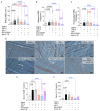Targeting P-selectin and interleukin-1β in mice with sickle cell disease: effects on vaso-occlusion, liver injury and organ iron deposition
- PMID: 39568425
- PMCID: PMC11873698
- DOI: 10.3324/haematol.2024.286418
Targeting P-selectin and interleukin-1β in mice with sickle cell disease: effects on vaso-occlusion, liver injury and organ iron deposition
Abstract
Continuous vaso-occlusive and inflammatory processes cause extensive end-organ damage in adults with sickle cell disease (SCD), and there is little evidence that long-term hydroxyurea therapy prevents this. In initial trials, P-selectin blockade with crizanlizumab reduced SCD vaso-occlusive crisis frequency, and interleukin (IL)-1β inhibition in SCD patients, using canakinumab, lowered inflammatory markers. We used murine SCD models to examine the effects of acute and chronic blockade of P-selectin and of IL-1β on vaso-occlusive events, their inflammatory profile and organ health. Both approaches improved impaired cutaneous microvascular perfusion in SCD mice by reducing TNF-α-induced vaso-occlusion. Acute P-selectin blockade markedly reduced TNF-α-induced neutrophil-platelet aggregate formation in SCD mice, and decreased leukocyte- rolling movements in the microvasculature, while acute IL-1β inhibition attenuated microvascular leukocyte adhesion. Six weeks of IL-1β-blocking immunotherapy improved the inflammatory profile of SCD mice, considerably reduced hepatic fibrosis and provided some relief from lung injury. In contrast, although P-selectin blockade reduced glomerular congestion, no significant benefit to overall organ pathology was observed. Unexpectedly, while combining the two immunotherapies reduced microvascular occlusion, their prolonged use caused acute liver injury. Notably, inhibition of IL-1β, but not of P-selectin, remarkably decreased hemosiderosis, in association with reduced tissue macrophage infiltration and the correction of biomarkers of dysregulated iron turnover. Our findings suggest that the attenuation of inflammation, as well as of vaso- occlusive processes, may be crucial for mitigating organ damage in SCD. Future trials should explore the ability of cytokine blockade to prevent multi-organ damage in patients with SCD, beyond evaluating vaso-occlusive crisis frequency.
Figures








Similar articles
-
Lung vaso-occlusion in sickle cell disease mediated by arteriolar neutrophil-platelet microemboli.JCI Insight. 2017 Jan 12;2(1):e89761. doi: 10.1172/jci.insight.89761. JCI Insight. 2017. PMID: 28097236 Free PMC article.
-
Systematic Review of Crizanlizumab: A New Parenteral Option to Reduce Vaso-occlusive Pain Crises in Patients with Sickle Cell Disease.Pharmacotherapy. 2020 Jun;40(6):535-543. doi: 10.1002/phar.2409. Epub 2020 May 20. Pharmacotherapy. 2020. PMID: 32350885
-
Tandem P-selectin glycoprotein ligand immunoglobulin prevents lung vaso-occlusion in sickle cell disease mice.Exp Hematol. 2020 Apr;84:1-6.e1. doi: 10.1016/j.exphem.2020.03.002. Epub 2020 Mar 31. Exp Hematol. 2020. PMID: 32243995 Free PMC article.
-
Hydroxyurea with AKT2 inhibition decreases vaso-occlusive events in sickle cell disease mice.Blood. 2015 Nov 26;126(22):2511-7. doi: 10.1182/blood-2015-02-626234. Epub 2015 Aug 11. Blood. 2015. PMID: 26265698 Free PMC article.
-
Targeting Neutrophil Adhesive Events to Address Vaso-Occlusive Crisis in Sickle Cell Patients.Front Immunol. 2021 Apr 28;12:663886. doi: 10.3389/fimmu.2021.663886. eCollection 2021. Front Immunol. 2021. PMID: 33995392 Free PMC article. Review.
References
-
- Kato GJ, Piel FB, Reid CD, et al. . Sickle cell disease. Nat Rev Dis Primers. 2018;4:18010. - PubMed
-
- Rees DC, Williams TN, Gladwin MT. Sickle-cell disease. Lancet. 2010;376(9757):2018-2031. - PubMed
-
- Qari MH, Dier U, Mousa SA. Biomarkers of inflammation, growth factor, and coagulation activation in patients with sickle cell disease. Clin Appl Thromb Hemost. 2012;18(2):195-200. - PubMed
MeSH terms
Substances
LinkOut - more resources
Full Text Sources
Medical

